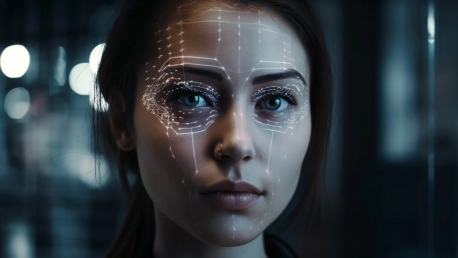Facial recognition technology stands at the forefront of the modern security versus privacy debate. This powerful tool enhances security, making identity verification swift and convenient across various sectors. Yet, it also stirs anxiety over privacy rights, as it encroaches upon individual freedoms with the potential for abuse. The crux of the issue lies in the handling of sensitive biometric information and the thin line it treads between bolstering safety measures and infringing on personal liberties. As facial recognition systems become more integrated into our lives, it is paramount to address the balance between its benefits in security and the risks to personal privacy. The challenge ahead is to manage the technology’s deployment responsibly, ensuring it’s a shield against threats rather than a sword against privacy.
The Mechanics of Facial Recognition
Facial recognition operates through advanced algorithms that detect and process facial characteristics from images or video feeds. This sophisticated identification process commences by pinpointing key facial attributes, such as the spacing of the eyes, the contour of the cheekbones, and the shape of the jawline. These tangible features are mathematically mapped, creating a unique facial signature for every individual. Subsequently, these personal facial maps are converted into digital models and analyzed. As they are compared to pre-existing data within a facial recognition database, they function as the linchpins in affirming or refuting the identity of a person. The technology’s precision in discerning individual identities hinges singularly on the complexity of these facial algorithms.In translating the unique facial contours into a digital format, this technology devises an intricate digital identity. It encompasses characteristic details and quantitative analysis to ensure the reliability of the recognition process. Every detail serves as an integral part of the digital fingerprint that is stored, retrieved, and referenced in identity verification encounters.
Integration Across Industries
The versatility and dependability of facial recognition have facilitated its infiltration into an array of sectors, from law enforcement to commercial settings. In the sphere of public security, facial recognition acts as an ever-vigilant sentinel. It adeptly identifies persons of interest and can be paramount in the prevention of criminal activities. Personal device manufacturers harness it to simplify user access, thereby simplifying the convoluted array of passwords and PINs previously necessitated for security with a more intuitive and secure method: the human face itself.This technology has not only revolutionized security protocols but has galvanized industries to reinvent interaction dynamics. Within the retail sector, for instance, facial recognition is pivotal in curating individualized customer experiences. It has the capacity to recognize loyal patrons and tailor services in real time, fostering a connection that traditional customer service methods cannot replicate.
Enhancing Security with Facial Recognition
Proponents of facial recognition technology argue that it stands as a sentinel of modern security. Secure areas and devices, now bound to the unique biometric patterns of an individual’s facial structure, have ostensibly become impervious to traditional methods of unauthorized access. The convenience of facial recognition extends its appeal. No longer does one need to fumble with keys or recall complicated passwords. Instead, the mere presence of a person’s visage suffices to grant entry or deny access, seamlessly fortifying the notion of security in our digital age.Embracing facial recognition marks a paradigm shift. While conventional security strategies relied on replaceable or knowable tokens, facial recognition calls upon one’s innate, immutable characteristics. This shift significantly mitigates the risk of identity theft and intrusion, as forging biometric data is exceedingly more complex than guessing a password or duplicating an access card.
The Convenience Factor
Facial recognition technology isn’t just about enhancing security—it’s also revolutionizing convenience. At airports, gone are the days of time-consuming inspections. Now, travelers can breeze through checkpoints thanks to real-time, automated identity verification, which keeps up with the non-stop pace of travel.The finance sector is also capitalizing on these advancements, employing facial recognition for faster transaction verification. This streamlines banking services, meeting modern expectations for quick and efficient digital interactions. Such innovations in identity confirmation are transforming how we conduct daily activities, marrying security with the seamless flow of our fast-paced lifestyles. These sectors are just the tip of the iceberg, as facial recognition’s blend of security and efficiency continues to reshape our world.
Navigating Privacy Concerns
Notwithstanding, the ascent of facial recognition technology has ignited a firestorm of privacy issues. The capability to track and identify people without their explicit consent stands in stark contrast to personal privacy expectations. Concerns mount as the collection and storage of biometric data transition from opt-in scenarios to seemingly omnipresent surveillance, ripe for potential misuse.The ease with which facial recognition systems capture and analyze an individual’s biometric data without their active engagement raises profound ethical questions. Public discourse grapples with the intersection of burgeoning technological capabilities and the requisite respect for personal boundaries, as society endeavors to chart a course that preserves privacy while reaping the benefits of enhanced security.
Addressing Bias and Inaccuracies
While facial recognition technology boasts impressive advancements, it is not insulated from technical flaws and biases. Algorithms, if trained on non-representative data sets, can inadvertently result in discriminatory practices, yielding different accuracy rates across diverse user demographics. These discrepancies not only diminish the reliability of such systems but also perpetuate inequalities.Further, the possibility of erroneous identification by facial recognition systems can escalate to graver consequences, beyond mere inconvenience. The reliability and credibility of these systems are pivotal, especially when they play a role in critical decision-making processes. Ensuring equity and precision demands relentless refinement and robust testing against a backdrop of diversity to overcome inherent biases and probabilistic inaccuracies.
The Path Forward
Navigating the future of facial recognition technology involves striking a critical balance. On one hand, there’s the potential to bolster security capabilities; on the other, there’s the pressing need to protect personal privacy. The ethical use and legal structuring of the technology spotlight society’s engagement with privacy and innovation. Discussions hinge on how facial recognition will be integrated—will it lead to widespread surveillance or become a reliable tool for security? The outcome depends on how principles of ethical use guide its implementation and how deeply the privacy concerns are considered and addressed. The key is to craft a framework that ensures the technology is used responsibly while also maintaining the public’s trust in how their facial data is used and protected.









